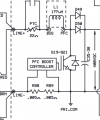Please help identify the component located at Q26 of the 0558 102 426 PCB Power board assembly-CSA.
The component at Q26 has blown and the machine will not power up.
This board is from an ESAB EM215ic mig welder, it runs on 220 Volts or 110 v using Power cord adapter (120/230V), no switch.
On the circuit, Q26 is connected to 2 x 7w10kj cgs16.11 i believe are resistors.
Is this a DPAK mosfet ?,
The markings on my blown Q26 component is VNH19 ON 3N - ON is for Onsemi. Onsemi has no record of it. it measures 6 x 6 mm +-
A similar request for identification on the web has VNH11 ON 3N or an other has F50 ON 3N -could be a U.S. board.
See pictures: 7W10KJ x2-to Q26-20240105_112217.jpg, 20240109_110823.jpg and Q26 to 7W10KJ-20240105_112320.jpg
Thank You .......



The component at Q26 has blown and the machine will not power up.
This board is from an ESAB EM215ic mig welder, it runs on 220 Volts or 110 v using Power cord adapter (120/230V), no switch.
On the circuit, Q26 is connected to 2 x 7w10kj cgs16.11 i believe are resistors.
Is this a DPAK mosfet ?,
The markings on my blown Q26 component is VNH19 ON 3N - ON is for Onsemi. Onsemi has no record of it. it measures 6 x 6 mm +-
A similar request for identification on the web has VNH11 ON 3N or an other has F50 ON 3N -could be a U.S. board.
See pictures: 7W10KJ x2-to Q26-20240105_112217.jpg, 20240109_110823.jpg and Q26 to 7W10KJ-20240105_112320.jpg
Thank You .......





















